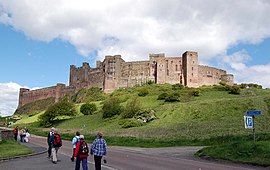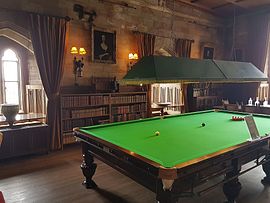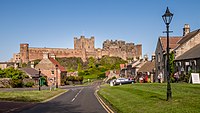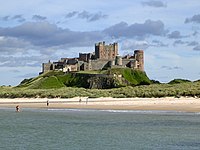
Northumbria was an early medieval Anglo-Saxon kingdom in what is now Northern England and south-east Scotland.
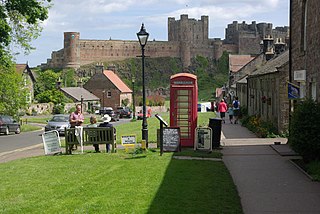
Bamburgh is a village and civil parish on the coast of Northumberland, England. It had a population of 454 in 2001, decreasing to 414 at the 2011 census.
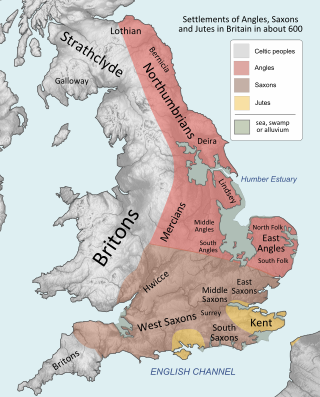
Æthelfrith was King of Bernicia from c. 593 until his death around 616 AD at the Battle of the River Idle. He became the first Bernician king to also rule the neighboring land of Deira, giving him an important place in the development and the unification of the later kingdom of Northumbria. He was especially notable for his successes against the Britons and his victory over the Gaels of Dál Riata. Although he was defeated and killed in battle and replaced by a dynastic rival, his line was eventually restored to power in the 630s.
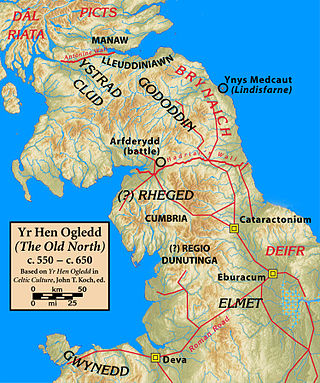
Bernicia was an Anglo-Saxon kingdom established by Anglian settlers of the 6th century in what is now southeastern Scotland and North East England.

Ida is the first known king of the Anglian kingdom of Bernicia, which he ruled from around 547 until his death in 559. Little is known of his life or reign, but he was regarded as the founder of a line from which later Anglo-Saxon kings in this part of northern England and southern Scotland claimed descent. His descendants overcame Brittonic resistance and ultimately founded the powerful kingdom of Northumbria.

Norham is a village and civil parish in Northumberland, England. It is 7 miles (11 km) south-west of Berwick on the south side of the River Tweed where it is the border with Scotland.
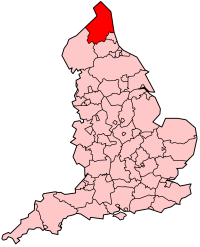
Northumberland, England's northernmost county, is a land where Roman occupiers once guarded a walled frontier, Anglian invaders fought with Celtic natives, and Norman lords built castles to suppress rebellion and defend a contested border with Scotland. The present-day county is a vestige of an independent kingdom that once stretched from Edinburgh to the Humber, hence its name, meaning literally 'north of the Humber'. Reflecting its tumultuous past, Northumberland has more castles than any other county in England, and the greatest number of recognised battle sites. Once an economically important region that supplied much of the coal that powered the industrial revolution, Northumberland is now a primarily rural county with a small and gradually shrinking population.
Hussa was the seventh known ruler of the Anglo-Saxon kingdom of Bernicia, ruling for seven years from about 585 to about 592.
This timeline summarises significant events in the history of Northumbria and Northumberland.
Earl of Northumbria or Ealdorman of Northumbria was a title in the late Anglo-Saxon, Anglo-Scandinavian and early Anglo-Norman period in England. The ealdordom was a successor of the Norse Kingdom of York. In the seventh century, the Anglo-Saxon kingdoms of Bernicia and Deira were united in the kingdom of Northumbria, but this was destroyed by the Vikings in 867. Southern Northumbria, the former Deira, then became the Viking kingdom of York, while the rulers of Bamburgh commanded territory roughly equivalent to the northern kingdom of Bernicia. In 1006 Uhtred the Bold, ruler of Bamburgh, by command of Æthelred the Unready became ealdorman in the south, temporarily re-uniting much of the area of Northumbria into a single jurisdiction. Uhtred was murdered in 1016, and Cnut then appointed Eric of Hlathir ealdorman at York, but Uhtred's dynasty held onto Bamburgh. After the Norman Conquest the region was divided into multiple smaller baronies, one of which was the earldom of Northumberland, with others like the earldoms of York and numerous autonomous liberties such as the County Palatine of Durham and Liberty of Tynedale.
Eadwulf or Eadulf was ruler of Bamburgh in the early tenth century. A genealogy in the twelfth-century text De Northumbria post Britannos recording the ancestry of Waltheof Earl of Northampton, makes Eadwulf the son of Æthelthryth daughter of Ælla, King of Northumbria, but no source names Eadwulf's own father.
Uhtred of Bamburgh, was ruler of Bamburgh and from 1006 to 1016 the ealdorman of Northumbria. He was the son of Waltheof I, ruler of Bamburgh (Bebbanburg), whose family the Eadwulfings had ruled the surrounding region for over a century. Uhtred's death by assassination was described in De obsessione Dunelmi and has been interpreted as the beginning of a blood feud. Not to be confused with Uhtred the son of Eadwulf I of Bamburgh, which is why he historically has been referred to as Uhtred the Bold.
Hering, son of Hussa was a Bernician prince. He was the son of Hussa, king of Bernicia from 585 to 592 or 593. After Hussa's death the kingdom went to Æthelfrith, Hering's cousin. During the first half of Æthelfrith's reign, Hering fled to Dál Riata, where he was given refuge by their king, Áedán mac Gabráin.
Eadwulf I was king of Northumbria from the death of Aldfrith in December 704 until February or March of 705, when Aldfrith's son Osred was restored to the throne.

Joyous Gard is a castle featured in the Matter of Britain literature of the legend of King Arthur. It was introduced in the 13th-century French Prose Lancelot as the home and formidable fortress of the hero Lancelot after his conquest of it from the forces of evil. Le Morte d'Arthur identified it with Bamburgh Castle.
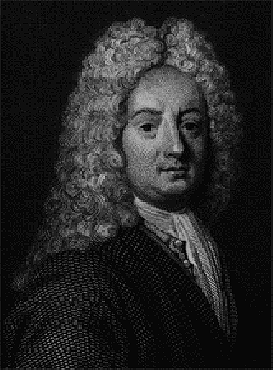
Thomas Forster, of Adderstone Hall, Northumberland, was an English landowner and Tory politician who sat in the House of Commons from 1708 to 1716. He served as a general of the Jacobite army in the 1715 Uprising and subsequently fled to France.

St Aidan's Church is a Grade I listed Church of England building in the Diocese of Newcastle.
Philip of Oldcoates was an English nobleman and royal official.

Waren, also known as Warn, Waren Bay, Warenmouth and Warenquay, was a seaport at Budle Bay, on the north-east coast of England, the recorded history of which spans from the 1240s to the early twentieth century.


